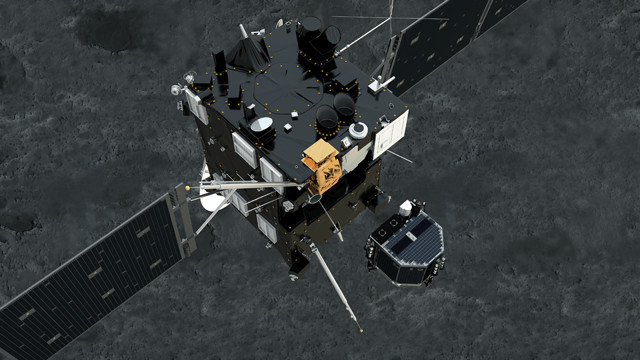
by Harvey Leifert Wednesday, September 28, 2016

Taken from an animation, these still shots illustrate the Philae lander separating from Rosetta and descending. Credit: ESA/ATG medialab.
Rosetta’s Philae lander made the first landing on the surface of a comet when it touched down on Nov. 12, 2014, three months after Rosetta began orbiting 67P. The landing, though historic, did not go as planned, and Philae was unable to accomplish much of the scientific program that had been scheduled for its 10 instruments.
The problem was that the three-legged touchdown was too soft. In gymnastic terms, Philae did not stick the landing, but bounced twice. Harpoons meant to anchor the lander to the ground did not deploy properly, and Philae nearly achieved escape velocity from the low-gravity comet on its first bounce.
When Philae finally came to rest, it was essentially undamaged, but it found itself in almost permanent deep shadow and therefore unable to adequately recharge its solar batteries. Its exact location, wedged in a dark crack on 67P, was only discovered on Sept. 2, less than a month prior to Rosetta’s demise, by its narrow-angle, high-resolution OSIRIS (Optical, Spectroscopic and Infrared Remote Imaging System) camera. At the time, Rosetta was in a low orbit, within 2.7 kilometers of the comet’s surface. Still, many of Philae’s scientific observations scheduled for the period immediately following its landing were made and the data were relayed to mission control via Rosetta.
Seven months after touchdown, Philae had stored enough solar energy to send several short data transmissions to controllers, after which it has remained silent. It continues to orbit the sun on 67P, but following the demise of Rosetta and its relay capability, Philae can no longer communicate with Earth.
© 2008-2021. All rights reserved. Any copying, redistribution or retransmission of any of the contents of this service without the expressed written permission of the American Geosciences Institute is expressly prohibited. Click here for all copyright requests.